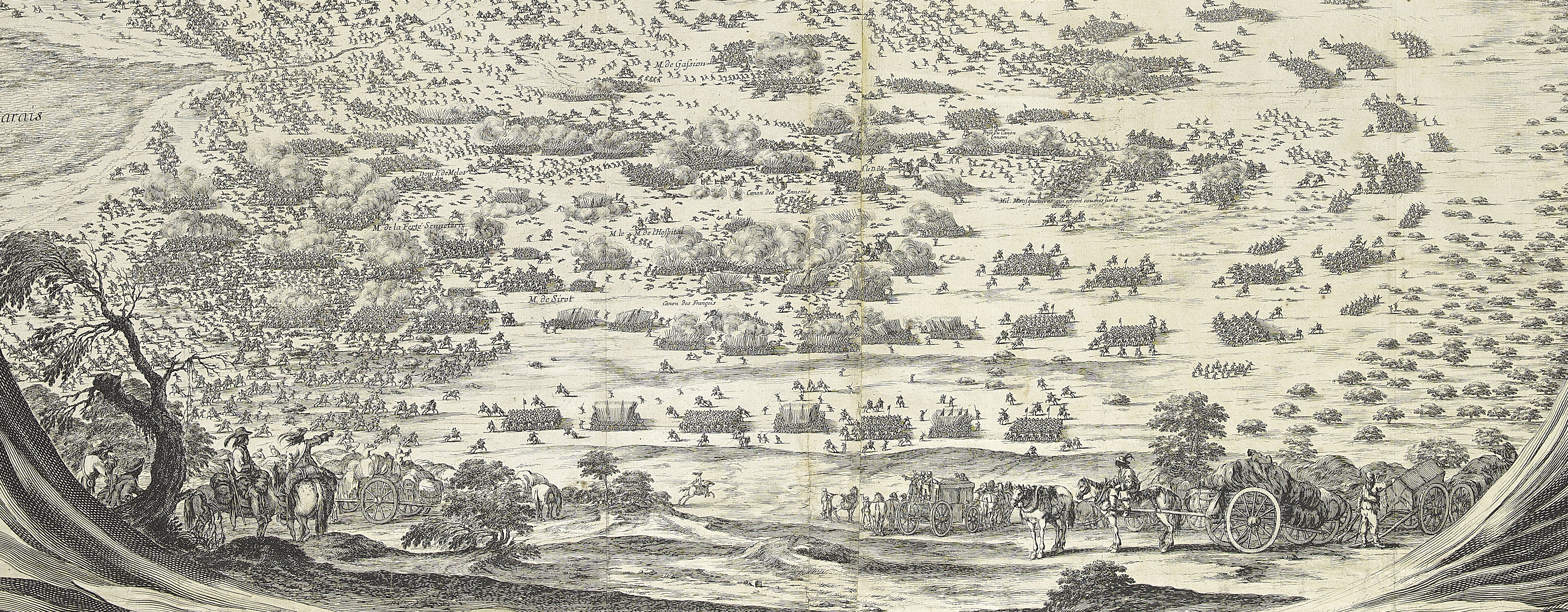
Maps, prints and letterpress text covering the major battles and sieges of the war
View of Nuremberg, 1632 (Nuremberg, Bavaria, Germany) 49°27ʹ15ʺN 11°04ʹ39ʺE
published 1632Engraving; printed on paper; mounted on paper (Mount Type A) | 23.0 x 36.7 cm (image and sheet) | RCIN 722067
A high oblique view of Nuremberg, held by the Swedish army and besieged in September 1632 by the combined Imperial and Bavarian armies, commanded by Albrecht von Wallenstein (24 September 1583-25 February 1634) resulting in an indecisive outcome but effecting the withdrawal from the area by Gustavus Adolphus in November 1632. Thirty Years War (1618-1648). Oriented with north to top.
Nuremberg was one of the free cities which had joined the Protestant Union of Ahausen in 5 May 1608 (Pagès, 1970, p.57) and, in early 1632, had given Gustavus Adolphus a warm welcome when he arrived en route for the Danube and the occupation of most of Bavaria. However, the Imperial forces of Wallenstein linked up with those of Bavaria so that by the Autumn campaign Gustavus Adolphus and the Swedish army faced, outside Nuremberg, a formidable enemy army. His attack on the besieging Imperial forces, who were besieging his position at Nuremberg (shown in this print), failed and he broke camp in November (after this print was made) and moved north towards Erfurt.
Giacomo Marcucci (fl. 1624-32) (engraver) [bottom right, inside neatline:] In Napolii A di primo de ottobre 1632. Iacomo Marcucci fecit.
Giovanni Orlandi (active 1590-1646) (publisher) [top left, bottom of rectangular panel:] In Napli per Giouanni Orlandi / Romano alla Pietá.
Subject(s)
Army-SwedenArmy-BavarianWatermark: Map: fleur-de-lys in circle, crown above. Mount: none.
Condition: no fold lines to the map; one fold line to the mount; slight brown staining; no gilt edges; mottled brown stains
23.0 x 36.7 cm (image and sheet)
cropped (platemark)
35.0 x 47.4 cm (mount)
Printed title:
Vero, et realissimo Disegno dell’ Assedio di Norimberga / doue hora si ritroua assediato, et insieme ridotto à mal par / tito il Re’diSuetia, il quale assedio è il piu’ industrio,so che da gr- / an tempo in qua’ sia stato inuentato poiche detta Cita uien / circondata da otto Forti reali, ciascheduno presidiato da dieci / mila combattenti, e munitionato con 15 · cannoni li quali ascien / deno al numero di 120 · batteno giorno, e notte detta Piazza, / si che hanno l’Imperiali totalmente chiusi li passi, che in alcun / modo non puo’ entrarui socorso, nè meno esso Rè puo uscire, / sta però aspettando socorso, dal suo gran Canceliere al qua / le se li è opposto il Colonello Galasso con sette milla Caualli, / et alcune millara di Fanti Vi è Carestia grande di ogni / cosa necessaria [crossed out:] di 20 settembre 1632 [top right, in rectangular panel]
Additional text:
[top left, in rectangular panel:] Nota come Curpaieris é gente / dell’ Elettore di Bauiera / Il Trincerone fatto dal Suetia / che quasi circonda tutta la / Cittá rinchiude un grandis.mo / Bosco nel quale è quartierata / quasi tutta la sua soldatesca.
Annotations:
George III heading: Nurnberg besieged by the Imperialists in 1632.
Other annotations: (Recto) none. (Verso) [top left, black pencil, cropped:] II/[?]; [right, black pencil:] II/45.
George III catalogue entry:
Nurnberg Il Re de Suetia e Norimberga assediata dall’Imperiali, 1632: da I. Marcucci, apresso G. Orlandi, 1632.
Subject(s)
Nuremberg, Bavaria, Germany (49°27ʹ15ʺN 11°04ʹ39ʺE)
Bibliographic reference(s)
M. McDonald, The Print Collection of Cassiano dal Pozzo. Part II, Architecture, Topography and Military Maps, 3 vols, London 2019, cat. no. 2939
Page revisions
25 May 2024
Current version






